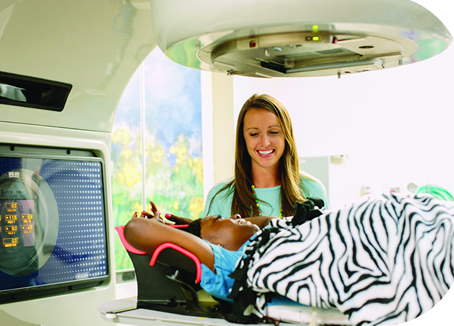Precise Treatment, Precise Care

Radiation Oncology takes a patient and family centered approach
Patients who receive radiation therapy understand that the process often comes with anxiety. In order to best appreciate the wants and needs of patients and families, the Department of Radiation Oncology formed a Patient and Family Centered Care (PFCC) committee. The goal of the group, which consists of former radiation patients, family members and radiation therapy caregivers, is to offer patients and families the opportunity to reflect on their treatment and recommend potential ways to improve the experience for others.
"Both pediatric and adult patients may experience anxiety about their appointments and treatments," says Kristan Freitag, a child life specialist in radiation oncology. "Rather than guessing what our patients and families want and need, we realized it was best to ask them."
Because Freitag's role involved helping patients and families cope through radiation therapy, the Department of Radiation Oncology tapped her expertise in the area of patient and family centered care, a well-established practice among pediatric patients at C.S. Mott Children's Hospital.
Freitag, along with Joumana Dekmak, the radiation therapist supervisor, leads the PFCC committee. The group currently includes six advisers (former patients or family members), as well as a variety of clinical staff, including physicians, radiation therapists and supervisors. The committee meets monthly.
"Radiation therapy varies depending on the doctor's prescription," says Dekmak. "We work hard to calm the patient and set expectations on the first day. Radiation feels no different from receiving an X-ray, but some patients require special immobilization when they're on the table. This can be stressful."
Treatment can take as little as 10 minutes, or as long as an hour depending on the patient's treatment prescription. Because patients cannot move, they are encouraged to listen to music or audio books for distraction.
"We've tried to improve the patient experience by having iPods in each room with different types of music, guided imagery and books. We also project a night sky on the ceiling to help patients relax," Freitag says.
The goal, Dekmak says, is to take the time to understand patient concerns so they can be addressed on the first day of treatment.
Improvements have already begun since increasing the focus on patients and families. The number of pediatric patients requiring anesthesia during radiation treatment due to anxiety has been reduced from around 40 percent to just 3 percent. The same types of techniques have been implemented with anxious adult patients.
"Often the fear of the unknown can be scarier than the actual treatment," Freitag says. "The best way to improve the patient experience is individualized patient preparation and patient and family involvement throughout the treatment journey."
How you can help
Email Kristan Freitag at [email protected] if you’re interested in improving the future of patient care for those receiving radiation therapy.
Read the Spring, 2015 issue of Thrive.
Learn more about Patient and Family Centered Care
Patient and family centered care approach in the Department of Radiation Oncology
